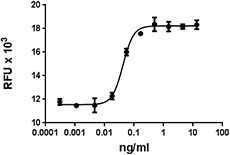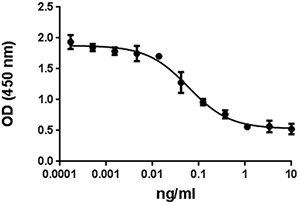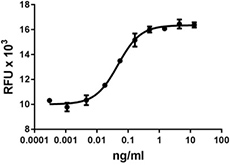- Regulatory Status
- RUO
- Other Names
- ALRH, BHR1, P600, IL-13, MGC116786, MGC116788, MGC116789, IL13
- Ave. Rating
- Submit a Review
- Product Citations
- 8 publications
| Cat # | Size | Price | Quantity Check Availability | Save | ||
|---|---|---|---|---|---|---|
| 571106 | 100 µg | 1172 CHF | ||||
| 571108 | 500 µg | 3000 CHF | ||||
| 571110 | 2 µg | 75 CHF | ||||
| 571102 | 10 µg | 229 CHF | ||||
| 571104 | 25 µg | 464 CHF | ||||
Human IL-13 was initially cloned from cDNA libraries of activated T cells. IL-13 is an immunoregulatory cytokine secreted predominantly by activated T(H)2 cells, and it is a key mediator in the pathogenesis of allergic inflammation. IL-13 shares many functional properties with IL-4, and they share a common receptor subunit, the alpha subunit of the IL-4 receptor (IL-4Ralpha). IL-13 mediates its effects by interacting with a complex receptor system comprised of IL-4Ralpha and two IL-13 binding proteins, IL-13Ralpha1 and IL-13Ralpha2. Ligation of the IL-13 receptor complex results in signaling via the insulin receptor substrate (IRS)-1 and 2 and STAT-6 pathways. IL-13, like IL-4, is a cytokine produced by T(H)2 type helper T cells in response to signaling through the T cell antigen receptor and by mast cells and basophils upon cross-linkage of the high-affinity receptor for immunoglobulin E (IgE). IL-13 has been implicated in airway hypersensitivity and mucus hypersecretion, inflammatory bowel disease, and parasitic nematode expulsion.
Product DetailsProduct Details
- Source
- Human IL-13, amino acids Gly21-Asn132 (Accession# X69079), was expressed in E. coli.
- Molecular Mass
- The 112 amino acid recombinant protein has a predicted molecular mass of 12,344 Da. The DTT-reduced and non-reduced protein migrate at approximately 9kDa by SDS-PAGE. The N-terminal amino acid is Glycine.
- Purity
- Purity is >98%, as determined by Coomassie stained SDS-PAGE.
- Formulation
- 0.22µm filtered protein solution is in 10mM NaH2PO4, 150mM NaCl, pH 7.2.
- Endotoxin Level
- Endotoxin level is < 0.1 EU/µg (< 0.01ng/µg) protein as determined by the LAL method.
- Concentration
- 10 and 25 µg sizes are bottled at 200 µg/mL. 100 µg size and larger sizes are lot-specific and bottled at the concentration indicated on the vial. To obtain lot-specific concentration and expiration, please enter the lot number in our Certificate of Analysis online tool.
- Storage & Handling
- Unopened vial can be stored between 2°C and 8°C for up to 2 weeks, at -20°C for up to six months, or at -70°C or colder until the expiration date. For maximum results, quick spin vial prior to opening. The protein can be aliquoted and stored at -20°C or colder. Stock solutions can also be prepared at 50 - 100 µg/mL in appropriate sterile buffer, carrier protein such as 0.2 - 1% BSA or HSA can be added when preparing the stock solution. Aliquots can be stored between 2°C and 8°C for up to one week and stored at -20°C or colder for up to 3 months. Avoid repeated freeze/thaw cycles.
- Activity
- The ED50 is 0.5 to 3ng/ml, corresponding to a specific activity of 0.33 — 2.0 x 106 units/mg, as determined by the dose dependent stimulation of TF-1 cells proliferation.
- Application
-
Bioassay
- Application Notes
-
BioLegend carrier-free recombinant proteins provided in liquid format are shipped on blue-ice. Our comparison testing data indicates that when handled and stored as recommended, the liquid format has equal or better stability and shelf-life compared to commercially available lyophilized proteins after reconstitution. Our liquid proteins are verified in-house to maintain activity after shipping on blue ice and are backed by our 100% satisfaction guarantee. If you have any concerns, contact us at tech@biolegend.com.
- Product Citations
-
Antigen Details
- Structure
- Cytokine
- Distribution
-
IL-13 is secreted by activated T cells, Th2 cells, basophils, mast cells, activated eosinophils and NK cells
- Function
- IL-13 modulates human monocytes/macrophages and B cells. IL-13 induces an increase of MHC class II expression in human monocytes/macrophages, and direct inhibition of inflammatory cytokines such as TNF-α and IL-1β
- Interaction
- IL-13 receptors are expressed on human B cells, basophils, eosinophils, mast cells, endothelial cells, fibroblasts, monocytes, macrophages, respiratory epithelial cells, and smooth muscle cells
- Ligand/Receptor
- IL-4Ralpha, IL-13Ralpha1, and IL-13Ralpha2
- Biology Area
- Cell Biology, Immunology, Neuroinflammation, Neuroscience
- Molecular Family
- Cytokines/Chemokines
- Antigen References
-
1. McKenzie ANJ, et al. P. Natl. Acad. Sci. USA 90:3735-3739 1993.
2. Papasavvas E, et al. J. Immunol. 175:5532-5540 2005.
3. Kelly-Wellch, et al. Science Signaling 293:2005.
4. Hershey GK J Allergy Clin Immunol 111:677-690 2003.
5. Harris J, et al. Immunity 27:505-517 2007.
6. LaPorte SL, et al. Cell 132:259-272 2008. - Gene ID
- 3596 View all products for this Gene ID
- Specificity (DOES NOT SHOW ON TDS):
- IL-13
- Specificity Alt (DOES NOT SHOW ON TDS):
- IL-13
- App Abbreviation (DOES NOT SHOW ON TDS):
- BA
- Hidden Names (DOES NOT SHOW ON TDS):
- Th2
- UniProt
- View information about IL-13 on UniProt.org
Related FAQs
- Why choose BioLegend recombinant proteins?
-
• Each lot of product is quality-tested for bioactivity as indicated on the data sheet.
• Greater than 95% Purity or higher, tested on every lot of product.
• 100% Satisfaction Guarantee for quality performance, stability, and consistency.
• Ready-to-use liquid format saves time and reduces challenges associated with reconstitution.
• Bulk and customization available. Contact us.
• Learn more about our Recombinant Proteins. - How does the activity of your recombinant proteins compare to competitors?
-
We quality control each and every lot of recombinant protein. Not only do we check its bioactivity, but we also compare it against other commercially available recombinant proteins. We make sure each recombinant protein’s activity is at least as good as or better than the competition’s. In order to provide you with the best possible product, we ensure that our testing process is rigorous and thorough. If you’re curious and eager to make the switch to BioLegend recombinants, contact your sales representative today!
- What is the specific activity or ED50 of my recombinant protein?
-
The specific activity range of the protein is indicated on the product datasheets. Because the exact activity values on a per unit basis can largely fluctuate depending on a number of factors, including the nature of the assay, cell density, age of cells/passage number, culture media used, and end user technique, the specific activity is best defined as a range and we guarantee the specific activity of all our lots will be within the range indicated on the datasheet. Please note this only applies to recombinants labeled for use in bioassays. ELISA standard recombinant proteins are not recommended for bioassay usage as they are not tested for these applications.
- Have your recombinants been tested for stability?
-
Our testing shows that the recombinant proteins are able to withstand room temperature for a week without losing activity. In addition the recombinant proteins were also found to withstand four cycles of freeze and thaw without losing activity.
- Does specific activity of a recombinant protein vary between lots?
-
Specific activity will vary for each lot and for the type of experiment that is done to validate it, but all passed lots will have activity within the established ED50 range for the product and we guarantee that our products will have lot-to-lot consistency. Please conduct an experiment-specific validation to find the optimal ED50 for your system.
- How do you convert activity as an ED50 in ng/ml to a specific activity in Units/mg?
-
Use formula Specific activity (Units/mg) = 10^6/ ED50 (ng/mL)

 Login / Register
Login / Register 















Follow Us